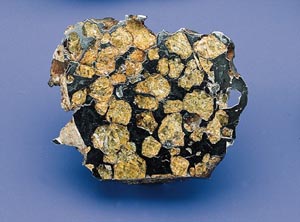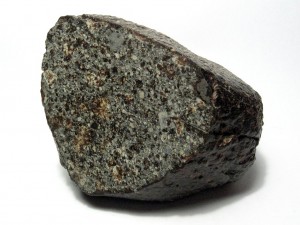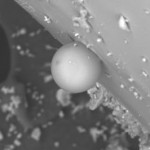A meteorite is a rock (usually small but sometimes very large) that breaks off of an asteroid, planet, or comet, and falls from space to earth. Due to their immense age and the fact that many of them haven't changed since they formed, meteorites were essential in dating our solar system and continue to provide clues on what the early universe looked like. By recording traces of cosmic rays and solar wind and flares, meteorites allow us to reconstruct the space environment and behavior of our sun.
Meteoroid (in space) → Meteor (in atmosphere) → Meteorite (on earth)
Stony Meteorites
Representing 95% of meteorites to hit earth, stony meteorites are composed of over 75% rocky silicates (such as pyroxene, plagioclase, and olivine), with small amounts of metallic nickel and iron. There are three types of stony meteroties: chondrites, carbonaceous chondrites, and achondrites.
Chondrites are the most common type of meteorite to hit earth (85%). Chondritic meteorites contain chondrules, rounded grains that formed as molten droplets during the solar system's youngest days. The chondrules, which are among the oldest solid materials in the universe, eventually accreted into asteroids, which would later break apart into meteorids. Since they formed very early and have not undergone alteration or differentiation, chondrules tell us about the formation and composition of the solar system.
Carbonaceous chondrites are chondrites that contain carbon compounds and water (or evidence of water, such as in the hydrous mineral serpentine). These meteorites could have kick-started life on earth by supplying amino acids. A very few carbonaceous chondrites contain small white fragments with rare minerals--spinel, melilite, fassaite, and perovskite--that only form at very high temperatures (1,500 - 2,000°C) and so could have been the first materials to condense from the solar nebula. These meteorites represent only 5% of chondrites landing on earth.
Achrondites lack chondrules, as the chondrules melted. Since they are altered, achrondites date younger than the unaltered chrondrites. Some achrondrites resemble terrestrial basalts, making them difficult to spot on earth.
Iron Meteorites
Iron meteorites are made up almost entirely nickel-iron alloys. They probably formed inside large asteroids (over 100 km across) that underwent differentiation, during which (much like on earth) the relatively heavy nickel-iron alloy sunk to the core of the asteroid. Iron meteorites represent less than 5% of meteorite falls on earth.
| Iron | almost entirely composed of nickel-iron alloys |  |
Stony Iron Meteorites
The rarest type of meteorite at just 1-2% of falls, stony iron meteorites contain roughly equal parts of silicates and nickel-iron alloys. Their extensive diversity in texture, composition, and chemistry makes them difficult to interpret.
| Stony Iron | contain equal parts silicates and nickel-iron alloys |  |
Further Resources
- Nice coverage of meteorite types, textures, and more, plus a good glossary:
http://www.cefns.nau.edu/geology/naml/ - An excellent easy-to-understand primer on meteorites: http://www.pibburns.com/catastro/meteors.htm#types
- A simple resource covering the basics: http://meteorites.asu.edu/meteorites/meteorite-types
- A thorough, more scientific introduction to meteorites, including many descriptions of thin sections: http://curator.jsc.nasa.gov/education/_documents/EducationMeteorite.pdf









